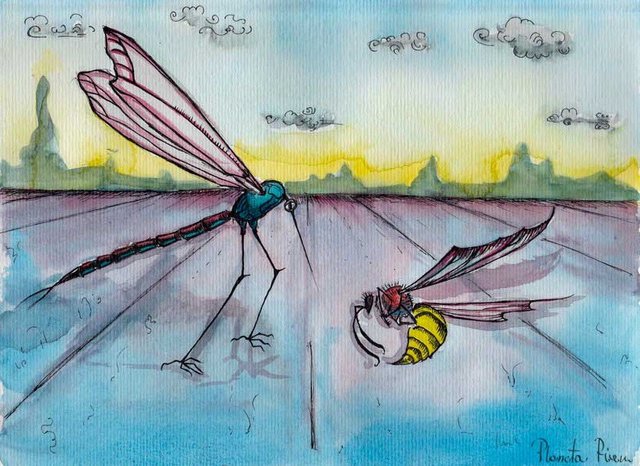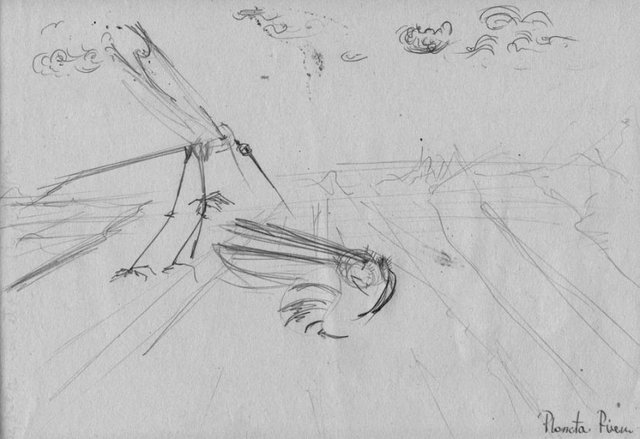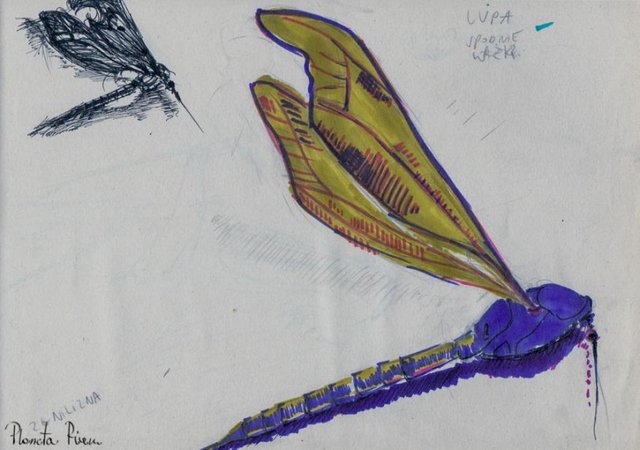Encounter, watercolor & ink [EN] | Spotkanie, akwarela i tusz [PL]

[EN]
Watercolor about spieces encounter. And sketches.
I painted based on the small remains of a male mosquito and a bee. I thought that bees are doing badly in the modern world. Concreted, monocultural and polluted with smog. Human activities have a negative impact on bee populations (Apidae), that is about 5,800 species described by humans. Including probably the most recognizable and loved honey bee (Apis mellifera). A fascinating being, with an interesting social structure and a complicated, hard life 😉
The main threats to the honey bee are:
- air pollution,
- loss of natural habitats,
- pesticides,
- electromagnetic waves (antropogenic),
- bacteria, viruses and mites (eg varroasis)
Most likely, these factors led to their massive extinction called CCD (Collony Collapse Disorder).
I do not know how the population of mosquitoes looks like, but sitting on the water in the summer I have the impression that they are biting mercilessly (females) and there are more and more of them every year; P
If you want to read more about CCD:
https://en.wikipedia.org/wiki/Colony_collapse_disorder
So our heroine,** Honey bee**, dies on concrete stretching to the grimy horizon. She has been killed by a man, not a mosquito;). The mosquito looks at her agony and no one else except him fears her fate.


[PL]
Akwarela o spotkaniu gatunków i szkice.
Malowałam wzorując się na małych szczątkach samca komara oraz pszczoły.
Pomyślałam, że pszczoły źle radzą sobie we współczesnym świecie. Zabetonowanym, monokulturowym i zanieczyszczonym smogiem. Działalność człowieka negatywnie wpływa na populacje pszczołowatych (Apidae), czyli około 5800 gatunków opisanych przez człowieka. W tym najbardziej chyba rozpoznawalna i uwielbiana pszczoła miodna (Apis mellifera). Gatunek fascynujący, o ciekawej strukturze społecznej i skomplikowanym, ciężkim życiu 😉
Główne zagrożenia dla pszczoły miodnej to:
- zanieczyszczenia powietrza,
- utrata naturalnych siedlisk i bioróżnorodności,
- pestycydy,
- fale elektromagnetyczne (antropogeniczne),
- bakterie, wirusy i roztocza (np. warroza).
Najprawdopodobniej te właśnie czynniki doprowadziły do masowego ich ginięcia zwanego** CCD (Collony Collapse Disorder).**
Nie wiem jak wygląda stan populacji komarów takich czy innych, ale siedząc nad wodą latem mam wrażenie, że kąsają niemiłosiernie (samice) i jest ich z roku na rok coraz więcej ;P
Jeśli chcecie poczytać więcej o CCD:
https://pl.wikipedia.org/wiki/Masowe_gini%C4%99cie_pszcz%C3%B3%C5%82
Tak więc nasza bohaterka Pszczoła umiera na betonie ciągnącym się aż po zasmolony horyzont. Ginie z rąk człowieka, nie komara;). Komar przygląda się jej agonii i nikt właściwie poza nim nie przejmuje się jej losem...:(
Awesome,
Great Painting and lovely angle
Thank You so much, nice to read it :)
Hello @planet-rium, thank you for sharing this creative work! We just stopped by to say that you've been upvoted by the @creativecrypto magazine. The Creative Crypto is all about art on the blockchain and learning from creatives like you. Looking forward to crossing paths again soon. Steem on!
Thank U so much! "Steem on" - I will. :)Peace.
Love the pastel colors in this piece. This image is so beautiful. Great art! @planet-rium
Oh, thank U. i like thie color too, sometimes I succeed ;>
Dear Artzonian, thanks for using the #ArtzOne hashtag. Your work is valuable to the @ArtzOne community. Quote of the week: Art, freedom and creativity will change society faster than politics. -Victor Pinchuk